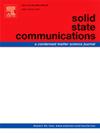Arsenic-doped HgCdTe: FTIR photoluminescence and photoreflectance spectroscopy study
IF 2.1
4区 物理与天体物理
Q3 PHYSICS, CONDENSED MATTER
引用次数: 0
Abstract
Photoluminescence (PL) and photoreflectance (PR) spectroscopy were used for the optical study of arsenic doping of HgCdTe grown by molecular beam epitaxy (MBE). Un-doped and arsenic-doped material with cadmium telluride molar fraction x = 0.29 grown under similar conditions and subjected to similar types of annealing was studied. The PL spectra of the un-doped material featured signatures of intrinsic defects associated with mercury vacancy, excessive tellurium, and related complexes. In the arsenic-doped material, optical signatures of these defects appeared to be suppressed. After arsenic activation, shallow (7–8 meV) acceptor levels were found in the material. These were attributed to the dopant activation, which was confirmed with electrical studies showing p-type conductivity with hole concentration ∼1016 cm−3. The studies showed that the actual pattern of arsenic doping in HgCdTe can be indeed screened by intrinsic defects, which are inherent to MBE-grown HgCdTe and tend to interact with the dopant.
砷掺杂碲化镉汞:傅立叶变换红外光发光和光反射光谱研究
光致发光(PL)和光致反射(PR)光谱被用于分子束外延(MBE)生长的碲化镉汞的砷掺杂光学研究。研究了在类似条件下生长的未掺杂和砷掺杂的碲化镉摩尔分数 x = 0.29 的材料,并对其进行了类似的退火处理。未掺杂材料的聚光光谱显示出与汞空位、过量碲及相关复合物有关的本征缺陷。在掺砷材料中,这些缺陷的光学特征似乎被抑制了。砷活化后,在材料中发现了较浅(7-8 meV)的受体水平。这归因于掺杂剂的活化,电学研究也证实了这一点,电洞浓度为 1016 cm-3 的材料具有 p 型导电性。研究表明,HgCdTe 中砷掺杂的实际模式确实可以被固有缺陷所屏蔽,这些缺陷是 MBE 生长的 HgCdTe 所固有的,往往会与掺杂剂相互作用。
本文章由计算机程序翻译,如有差异,请以英文原文为准。
求助全文
约1分钟内获得全文
求助全文
来源期刊

Solid State Communications
物理-物理:凝聚态物理
CiteScore
3.40
自引率
4.80%
发文量
287
审稿时长
51 days
期刊介绍:
Solid State Communications is an international medium for the publication of short communications and original research articles on significant developments in condensed matter science, giving scientists immediate access to important, recently completed work. The journal publishes original experimental and theoretical research on the physical and chemical properties of solids and other condensed systems and also on their preparation. The submission of manuscripts reporting research on the basic physics of materials science and devices, as well as of state-of-the-art microstructures and nanostructures, is encouraged.
A coherent quantitative treatment emphasizing new physics is expected rather than a simple accumulation of experimental data. Consistent with these aims, the short communications should be kept concise and short, usually not longer than six printed pages. The number of figures and tables should also be kept to a minimum. Solid State Communications now also welcomes original research articles without length restrictions.
The Fast-Track section of Solid State Communications is the venue for very rapid publication of short communications on significant developments in condensed matter science. The goal is to offer the broad condensed matter community quick and immediate access to publish recently completed papers in research areas that are rapidly evolving and in which there are developments with great potential impact.
 求助内容:
求助内容: 应助结果提醒方式:
应助结果提醒方式:


